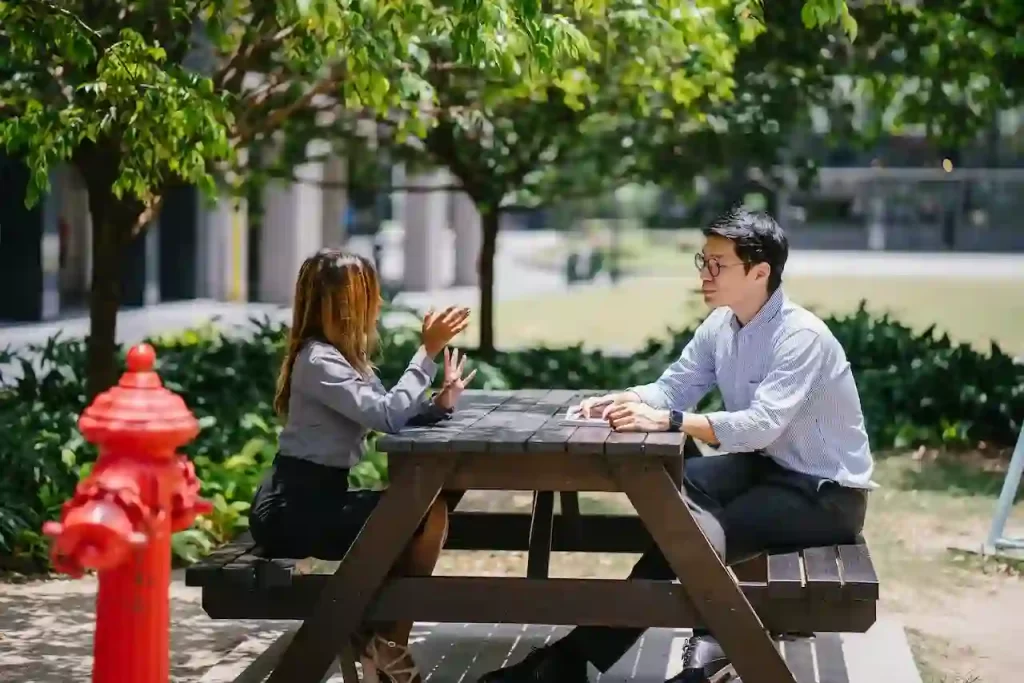Let’s be honest, in this fast-paced world, it’s easy to get caught up in our own bubble and forget the value of a good conversation. We’ve all been there, scrolling through our phones, surrounded by people, but feeling completely alone. That’s why I’m here to remind you of the importance of holding a conversation and why it should be a priority in our daily lives.
Now, you might be thinking, “I talk to people all the time, what’s the big deal?” Well, it’s not just about talking, it’s about connecting with others on a deeper level. When we engage in meaningful conversations, we not only learn from others but we also gain a new perspective and appreciation for different viewpoints. It allows us to broaden our horizons and grow as individuals.
In this article, we’ll explore the benefits of holding a conversation and provide tips on how to make the most out of your interactions with others. Whether you’re a social butterfly or a bit shy, this article is for you. We’ll cover topics such as active listening, body language, and how to keep the conversation flowing. By the end of this article, you’ll be equipped with the tools you need to have more meaningful conversations and improve your relationships with others.
So, let’s put down our phones, step out of our bubbles, and start connecting with the people around us. It’s time to rediscover the lost art of conversation.
Creating Intention
Alright, so you want to have a conversation with someone, but have you thought about what you want to achieve from it? Setting an intention before starting a conversation is essential to make sure you’re on the same page with the other person and that you both have a clear understanding of what you want to achieve.
Setting an intention can help you steer the conversation in the direction you want, prevent misunderstandings, and save time. You can set an intention for any type of conversation, whether it’s a casual chat with friends or a serious talk with your boss.
So, how do you set an intention? Well, it starts with knowing what you want to achieve. Maybe you want to express your feelings to someone, apologize for something you did, or ask for a favor. Whatever your goal is, make sure it’s specific and achievable.
For example, if you’re having a meeting with your boss, your intention could be to discuss a new project idea and get their feedback on it. Or, if you’re having a conversation with a friend, your intention could be to catch up and share some exciting news with them.
Once you’ve set your intention, it’s important to communicate it clearly to the other person. This will help them understand what you want to achieve from the conversation and how they can contribute to it. You can start by saying something like, “Hey, I wanted to talk to you about something specific today. My intention for this conversation is to…”
Remember, setting an intention doesn’t mean you have to control the conversation. Be open to new ideas and perspectives, and be willing to adjust your intention if necessary. The most important thing is to have a clear idea of what you want to achieve, so you can make the most of the conversation.
Intention Checks
We’ve all been there: we start a conversation with the best intentions, but somehow things start going awry. Perhaps we say something that comes across as insensitive or we misread the other person’s emotions. It’s easy to blame the other person for the conversation not going well, but have you considered that the issue might be with your intention?
Before starting any conversation, it’s essential to set a goal or intention. This helps you clarify what you want to achieve from the conversation and can help guide the conversation in a productive direction. However, simply setting an intention isn’t enough. You also need to do some intention checks before starting the conversation.
Firstly, ask yourself what your motive is for having the conversation. Are you looking to share your perspective, or do you want to understand the other person’s viewpoint? It’s crucial to make sure that your intention is not solely focused on yourself, but that you’re also considering the other person’s needs.
Next, consider the context in which you’re having the conversation. Is it an appropriate time and place to discuss the topic you have in mind? Also, consider the person you’re talking to. What do you know about their communication style? What might trigger them? Being mindful of the context and the person you’re talking to can help you tailor your conversation and ensure that it’s received well.
Setting an intention is essential, but it’s not enough. Before starting a conversation, ask yourself some intention checks. Consider your motives, the context, and the person you’re talking to. With these checks, you can ensure that your conversation is productive and achieves the goal you set out for.
Unique Questions
Have you ever been in a conversation where you felt like you were being asked the same generic questions over and over again? It’s not the most engaging experience, is it? That’s why asking unique and on-topic questions is so important.
Asking unique questions shows that you’re genuinely interested in the conversation and the person you’re talking to. When you ask questions that are specific to the topic at hand, it creates a more engaging and meaningful conversation. It also shows that you’re a great conversationalist who takes the time to listen and think about what’s being said.
Being the conversational question keeper is a role that many people shy away from, but it can have great advantages. By asking unique questions, you become the driving force behind the conversation. You can steer the conversation in a direction that’s interesting and engaging for everyone involved. It also means that you don’t have to worry about awkward silences or feeling like the conversation is lagging.
Asking unique questions can also help you learn more about the person you’re talking to. People love to talk about themselves, and when you ask them specific questions, you give them the opportunity to do just that. You might discover a shared interest or experience that you didn’t know you had, which can create a deeper connection between you and the person you’re talking to.
Asking unique and on-topic questions is a simple yet powerful way to improve your conversations. It shows that you’re engaged, interested, and willing to put in the effort to create a meaningful dialogue. So next time you find yourself in a conversation, take on the role of the conversational question keeper and see where it takes you!
Know the Taboos
When meeting someone new, it can be tempting to dive right into any topic that comes to mind. However, it’s important to remember that not all topics are created equal, and some may be considered taboo or inappropriate for certain situations. Understanding what subjects to avoid when meeting someone new can help you navigate conversations with more ease and avoid potential social blunders.
So, what are some subjects to avoid? Politics and religion are two topics that are often considered taboo in polite conversation, especially when meeting someone for the first time. Personal finances, health issues, and relationships can also be sensitive topics that may be best left for later conversations when you’ve established a deeper connection with the person.
It’s important to recognize that there’s an unspoken hierarchy of conversation topics, and not all topics are appropriate for every situation. For example, if you’re meeting someone in a professional setting, it may be best to stick to work-related topics rather than delving into personal matters.
Navigating the hierarchy of conversation topics can be tricky, but it’s all about reading the situation and the person you’re talking to. Pay attention to their body language and responses to gauge whether a topic is appropriate or not. If you’re not sure, it’s always better to err on the side of caution and avoid potentially sensitive subjects.
Knowing what subjects to avoid when meeting someone new can help you navigate conversations with more ease and avoid potentially awkward or uncomfortable situations. Remember, it’s not about censoring yourself or being overly cautious, but rather being aware of the context and the person you’re talking to. By doing so, you can establish a positive connection and build a stronger relationship with the person over time.
Active Listening
Have you ever had a conversation with someone who seemed to be more interested in hearing themselves talk than actually listening to what you had to say? It’s not a great feeling, is it? That’s why being an active listener is so important when it comes to having a successful conversation.
Active listening means being fully present in the moment, paying attention to what the other person is saying, and engaging with them. This doesn’t just involve hearing the words that are coming out of their mouth, but also paying attention to their body language and tone of voice. When you’re actively listening, you’re showing the other person that you value their thoughts and opinions.
So how can you show that you’re actively listening? Firstly, maintain eye contact and keep your body language open. Don’t cross your arms or look away when they’re speaking. You can also nod your head, smile, and ask follow-up questions to show that you’re engaged with what they’re saying.
Being an active listener can have a number of benefits. For one, it can help build trust between you and the other person. It can also help you gain a better understanding of their perspective and build empathy. Finally, active listening can also help you avoid misunderstandings and miscommunications.
If you want to have a successful conversation, it’s important to be an active listener. By showing that you’re fully present in the moment and engaged with what the other person is saying, you’ll not only make them feel heard and valued, but you’ll also gain a deeper understanding of their perspective.
Body Language
When we’re having a conversation, our body language can speak volumes. Even if you’re fully engaged in a conversation, if your body language is closed off, you might not be giving off the right signals. That’s why it’s important to be aware of your body language when talking to others.
One of the most important aspects of body language is eye contact. Looking someone in the eye is a sign of confidence and attentiveness. However, maintaining eye contact for too long can be intimidating or uncomfortable for some people. So, it’s important to find a balance and adjust your eye contact accordingly.
Posture is another crucial aspect of body language. Slouching or crossing your arms can make you appear uninterested or defensive. Instead, sit up straight with an open posture. This shows that you’re engaged in the conversation and open to what the other person has to say.
Facial expressions are also a key part of body language. Smiling and nodding can show that you’re interested in what the other person is saying. On the other hand, a frown or blank expression can indicate disinterest or boredom.
It’s also important to pay attention to the body language of others. Are they making eye contact, sitting up straight, and nodding along to the conversation? Or are they looking away, slouching, or crossing their arms? By being aware of their body language, you can adjust your own behavior to make them feel more comfortable and engaged in the conversation.
In short, body language can have a significant impact on how a conversation is perceived. By using open body language, making eye contact, and showing genuine interest through your facial expressions, you can ensure that you come across as attentive and engaged.
Practice
You might be thinking, “Practice? Why would I need to practice having a conversation?” But the truth is, just like any other skill, conversation takes practice to become better at it. The more you practice, the more comfortable and confident you become in your abilities.
One way to practice holding a conversation is to challenge yourself to have conversations with new people. This could be as simple as striking up a conversation with the cashier at the grocery store or introducing yourself to someone new at a party. By putting yourself out there and having conversations with people you don’t know, you’ll start to build your confidence and your ability to hold a conversation.
Another way to practice is to have mock conversations with friends or family. You can come up with a topic and take turns discussing it, giving each other feedback on how you did. This is a safe and supportive environment to practice in, and you can even record your conversations to review them later and see where you can improve.
When practicing, it’s important to pay attention to your body language, tone of voice, and listening skills. Are you making eye contact? Are you using open and inviting body language? Are you actively listening to what the other person is saying? These are all important skills to master in order to have successful conversations.
By practicing your conversation skills, you can become a better conversationalist. It’s not always easy, but the more you do it, the more comfortable and confident you will become. So don’t be afraid to put yourself out there and start practicing today!
Conclusion
Congratulations! You’ve made it to the end of this article on mastering the art of conversation. We’ve covered a lot of ground, from setting an intention and asking unique questions to being mindful of taboo subjects and using body language to show engagement. Now, let’s quickly recap the key tips we’ve discussed.
First, it’s important to set a goal or intention for the conversation, so you know what you want to achieve. Before starting a conversation, you should also consider the context and person you’re talking to, and ask yourself some intention-checking questions. Then, you can focus on asking unique and specific questions that show genuine interest in the other person.
It’s also crucial to be aware of taboo subjects and the unspoken hierarchy of conversation topics. By avoiding these subjects, you can ensure a smoother conversation that doesn’t cause discomfort for anyone involved.
Additionally, being an active listener and using appropriate body language can go a long way in showing your engagement in the conversation. And finally, don’t forget to practice! By practicing conversation skills, you can improve and become more confident in your ability to hold a conversation.
Overall, the benefits of holding a conversation are immense. It can lead to stronger relationships, improved communication skills, and even career opportunities. So, I encourage you to put these tips into practice and start mastering the art of conversation today.





